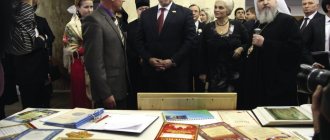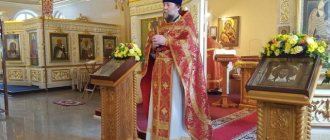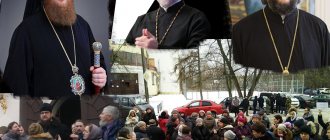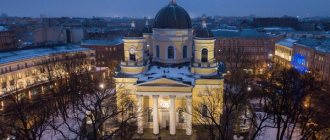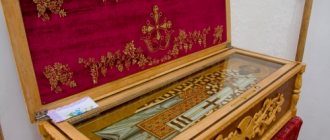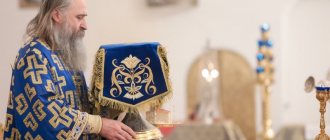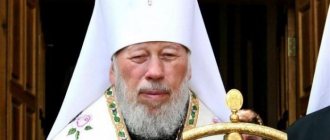| Metropolitan of Tambov and Rasskazovsky Theodosius (Vasnev) |
Theodosius (Vasnev)
(born 1961), Metropolitan of Tambov and Rasskazovsky, head of the Tambov Metropolis, rector of the Tambov Theological Seminary, holy archimandrite of the Tambov Kazan Monastery, member of the Inter-Council Presence of the Russian Orthodox Church in the World Sergei Ivanovich Vasnev, born January 26, 1961 in a working-class village Pichaevo, Tambov region, in the family of priest John Vasnev.
After graduating from high school and serving in the army in 1981, he entered the Moscow Theological Seminary, from which he graduated in 1984 with the first category. In the same year he became a student at the Moscow Theological Academy.
In January 1985, he was sent to Czechoslovakia to the Orthodox Theological Faculty of the University in Presov, where he received a higher theological education, graduating from the faculty in 1988 with the degree “Master of Theology” for an essay at the Department of Church History on the topic “The Baptism of Rus'.”
In the summer of 1985, as part of a group representing theological schools of the Russian Orthodox Church, he participated in the work of the Agape-5 International Youth Camp, held in Czechoslovakia and organized within the framework of the World Orthodox Youth Organization "Syndesmos".
On August 22, 1987, in the Trinity Cathedral of the St. Daniel Monastery in the city of Moscow, Metropolitan Philaret of Minsk and Belarus, Chairman of the Department of External Church Relations of the Moscow Patriarchate, was tonsured a monk with the name Theodosius - in memory of the Venerable Theodosius, abbot of the Kiev-Pechersk.
On August 28, 1987, in the Church of the Holy Chief Apostles Peter and Paul in Lefortovo, Moscow, Bishop Feofan of Kashira ordained him a hierodeacon.
On January 1, 1988, he was appointed to serve as a deacon at the Compound of the Russian Orthodox Church in Karlovy Vary, Czechoslovakia.
In the spring of 1988, at the Orthodox Theological Faculty in Presov (Czechoslovakia), he took part in the International Conference held by Syndesmos together with the World Federation of Christian Students (WFCS).
| Bishop Theodosius (Vasnev) |
On July 12, 1988, in the Church of the Holy Apostles Peter and Paul Compound of the Russian Orthodox Church in Karlovy Vary, Bishop Vladimir of Podolsk, rector of the Compound, ordained him a hieromonk and appointed to the position of cleric of the Peter and Paul Church of the Compound in Karlovy Vary.
From December 1989 to August 1990, he was in the Federal Republic of Germany, where he underwent a scientific internship at the Institute for Relations with the Eastern Churches in the city of Regensburg. As part of the training program, he visited Austria, Switzerland, France, Luxembourg, Belgium, Holland, and Italy.
In Venice, Ferrara, Florence in April 1990 he participated in the International Scientific Forum dedicated to the 550th anniversary of the Ferrara-Florence Council.
In mid-May 1990 in Tutzing (Germany), as part of a delegation of the Russian Orthodox Church, he took part in the International Symposium “Churches in the context of cultural diversity. On the way to the third millennium."
In August 1990, he was appointed to the position of assistant in the sector of foreign institutions of the Russian Orthodox Church of the Department for External Church Relations of the Moscow Patriarchate and at the same time became a resident of the Moscow St. Daniel Monastery.
In 1991, he was appointed head of the sector of foreign institutions of the Russian Orthodox Church in the Department of External Church Relations of the Moscow Patriarchate.
In 1992, with the blessing of the Hierarchy of the Russian Orthodox Church, he visited Tunisia with the aim of studying the possibility of opening a parish of the Moscow Patriarchate in this country.
In 1992, on the occasion of Easter, he was elevated to the rank of abbot.
On April 26, 1993, by determination of the Holy Synod, he was appointed head of the Russian Spiritual Mission in Jerusalem.
On May 22, 1993, the Patriarch of the Holy City of Jerusalem and All Palestine, Diodorus I, elevated him to the rank of archimandrite.
On March 12, 2002, by resolution of the Holy Synod, he was determined to be Bishop of Vetluzh, vicar of the Nizhny Novgorod diocese.
| Theodosius (Vasnev), bishop. Tambovsky and Michurinsky |
On April 19 of the same year, the naming took place in the Church in the name of All Saints who shone in the Russian Land, the Patriarchal residence in the St. Daniel Monastery in Moscow, and on April 21 in the Cathedral of Christ the Savior in Moscow, during the Divine Liturgy, the episcopal consecration, which was led by the Patriarch of Moscow and All Rus' Alexy II.
Concelebrating with him were: Metropolitans of Krutitsa and Kolomna Yuvenaly, Smolensk and Kaliningrad Kirill, Solnechnogorsk Sergius, Volokolamsk and Yuryev Pitirim, Tashkent and Central Asian Vladimir; Archbishops of Nizhny Novgorod and Arzamas Evgeniy, Istra Arseniy, Vereisky Evgeniy; bishops of Philippopolis Niphon (Patriarchate of Antioch), Orekhovo-Zuevsky Alexy, Dmitrovsky Alexander, Sergiev Posad Feognost, Perm and Solikamsk Irinarch, Bryansk and Sevsky Theophylact. From October 11, 2002 to February 2, 2003, he temporarily ruled the Nizhny Novgorod and Arzamas diocese.
From October 11 to December 26, 2002, he temporarily ruled the Tambov and Michurinsk diocese.
On December 26, 2002, he was appointed Bishop of Tambov and Michurinsk.
On April 20, 2005, he was appointed rector of the Tambov Theological Seminary.
Since 2006, he has been a member of the Public Chamber of the Tambov Region.
On December 27, 2011, he was confirmed as rector (hieroarchimandrite) of the Kazan Monastery in the city of Tambov [1].
Since December 26, 2012, he has been called “Tambov and Rasskazovsky”, and was also appointed temporary manager of the newly formed Michurinsk and Morshansk diocese and head of the newly formed Tambov Metropolis [2].
On January 3, 2013, he was elevated to the dignity of metropolitan by Patriarch Kirill of Moscow and All Rus' [3].
On November 20, 2021, he was included in the commission for worship and church art of the Interconciliar Presence of the Russian Orthodox Church [4].
No. 41 (890) / November 1 '16
Archpastor
In this topic:
Archpastor
Bishop of Kronstadt Nazariy: Holy Trinity Alexander Nevsky Lavra
Dear Master, we are pleased to welcome you to our studio. You participated in the Feofanovsky educational readings, organized by the Publishing Department of the Russian Orthodox Church. Please tell us about this event.
– I have already participated in Theophan’s readings several times, since I am the manager of the Tambov diocese, which, as you know, St. Theophan headed for 4 years.
This year the readings were held for the 10th time, and I tried to participate in them. He always gave reports, first of all, about the Tambov period of service of St. Theophan - he served for only 4 years, but this time was very bright and significant for the history of the Tambov diocese.
Saint Theophan was an amazing person - kind, a man of prayer. He is not only a well-known church writer - his organizational talent was also discovered in the Tambov region: he stood at the origins of the creation of the Tambov Diocesan Women's School and paid a lot of attention to its formation, made sure that the pupils were provided with everything and had a decent building.
Saint Theophan founded the Tambov Diocesan Gazette and determined the direction of development of this magazine. In recent years, we have revived it under its previous name - “Tambov Diocesan Gazette”.
The saint, as we know, was an icon painter, he paid a lot of attention to the theological seminary, always participated in meetings with students, took exams - he came up with the idea of opening an icon painting class at the Tambov Seminary. Being an icon painter, he made sure that worthy icons appeared in the churches and monasteries under construction in the Tambov region, advocating icons of Byzantine writing. To do this, he taught seminary students, and, receiving the basics of icon painting, becoming clergy, they made sure that worthy painting appeared in churches.
What is your participation in the Feofanov educational readings?
– As I already said, I took part in the readings almost every year, and, of course, we tried to ensure that they were always held with the participation of representatives of the Tambov diocese, not only teachers, but also students of the theological seminary. Readings took place in different places. They began, of course, in the Vyshensky Monastery, where Saint Theophan was in seclusion. Most often they probably take place here in Moscow, but several times they were also in the Tambov diocese, at the St. Petersburg Theological Academy and other cities where the saint ever served. In St. Petersburg the saint was rector, in the Tambov diocese - archpastor. In my opinion, readings were also held in the Vladimir diocese.
Each time during the readings, all aspects of the activities of St. Theophan, his missionary and educational service are covered. We also consider his epistolary heritage, of course, his interpretations of the letters of the Apostle Paul and the translations he performed, including the Philokalia.
He is such an amazing person and multifaceted personality that, although the readings have been held for the 10th time, I think they could be held dozens more times, and it is unlikely that it will be possible to fully illuminate all the facets of his ministry.
Today, a scientific edition of his works is being prepared. This work began on the eve of the 200th anniversary of the birth of St. Theophan, which we celebrated in 2015 (in fact, readings began several years before the celebration of this anniversary, in preparation for it).
In Tambov, we began to build a temple dedicated to St. Theophan, not far from the city center. The saint is loved and remembered throughout Russia, but perhaps especially by the people of Tambov: while ruling the diocese for 4 years, he visited churches and monasteries in all regions of the diocese. The Tambov diocese was very extensive, it even included the Sarov Monastery - today it is the Nizhny Novgorod Metropolis. Saint Theophan bore the title “Bishop of Tambov and Shatsk” - which means that the Shatsk region of the current Ryazan region was part of the Tambov diocese. Borisoglebsk district (today it is the Voronezh diocese), almost the entire Lipetsk region was also part of it, that is, it was a very large diocese. The saint visited all its churches and monasteries, got acquainted with the life of the parishes, made some adjustments, comments and, of course, consecrated churches, including those in monasteries. According to historical reference books, during the 4 years of his ministry, almost 60 churches were built - this is a very, very large number. Today we are building a temple that will become our tribute to this amazing saint.
Saint Theophan not only made many trips to parishes and monasteries, but he loved the Vyshenskaya Hermitage very much and, as we know, after he moved to the Vladimir diocese and asked to be employed, he turned to the Holy Synod with a request to settle in the Vyshenskaya Hermitage. Apparently, he really liked this monastery when he ruled the Tambov diocese because of its privacy. This is probably why he did not choose any of the Vladimir monasteries, but asked specifically to go to the Tambov land, which he seemed to love very much. And not only the land, but also the people.
Was the saint also buried in the Tambov diocese?
– The saint was buried in the Vyshensky Monastery, where his holy relics were found.
Several years ago you met with His Holiness Patriarch Kirill. I will quote what he said about the Tambov diocese: “Our Russian hinterland, indigenous Russia, a region with a great history, a hinterland that was outposts within our borders.” Please tell us about your diocese, the events associated with Theophan the Recluse, in particular, about these celebrations and the visit of His Holiness the Patriarch.
– Saint Theophan greatly revered Saint Pitirim of Tambov, who was buried in the cathedral (Saint Pitirim began to build it and bequeathed to bury himself in it). During the administration of the diocese by Saint Theophan, a book was already kept at the cathedral, where the miracles performed at the grave of Saint Pitirim were recorded. Saint Theophan treated them very kindly and continued to write this book. One part of it has been preserved and is kept by us; we republished it just in time for the anniversary of St. Pitirim, which we celebrated two years ago. Saint Theophan even left some notes in the margins of this book.
We recently celebrated the anniversary of St. Pitirim of Tambov. Of course, we prepared for it, our churches and monasteries were put in order, the beautiful cathedral was transformed for the anniversary. Together with the governor, we invited His Holiness Patriarch Kirill to the celebrations. And in 2014, His Holiness visited the Tambov Metropolis and led the celebrations of the 100th anniversary of the glorification of St. Pitirim in 1914 under Archbishop Kirill (Smirnov) of Tambov, who later became Metropolitan of Kazan, a new martyr.
During the visit, His Holiness performed a divine service and episcopal consecration in the Cathedral of the Holy Transfiguration, consecrated the monument to St. Pitirim, installed on Cathedral Square, and visited the actively reviving Kazan Monastery, where the Tambov Theological Seminary is now located. We restored the Church of St. John the Baptist, recreated the bell tower of the Kazan Monastery, which was blown up in the 30s - it is truly beautiful and majestic and is the dominant feature of the city: its height is 107 m. Of course, today it attracts pilgrims, and all guests of Tambov visit the Kazan Monastery and admire it a wonderful creation.
His Holiness also visited the Ascension Convent, located not far from the Transfiguration Cathedral. Saint Pitirim also stood at its origins, appointing his own sister Catherine as its first abbess. Now we have restored the Ascension Cathedral there, the minor consecration of which was carried out by Patriarch Kirill during his visit. The monastery continues to be restored, much remains to be done. But much of what was destroyed in the city of Tambov was restored through joint efforts - with the participation of our governor, the head of the city, and our patrons.
Question from a TV viewer, the head of the city of Tambov: – Everything that is connected with the improvement and beauty of the city of Tambov is connected, first of all, with you: those churches that you restored, simply brought to mind, are our “zest”, we are very We are proud, and for this I thank you very much on behalf of all Tambov residents.
Saint Theophan, about whom we have talked a lot and will continue to talk, is truly an extraordinary person, very important for us. But when will you and I open the temple that you are building?
– Thank you, Yuri Anatolyevich, for your assessment of our joint efforts to revive churches on Tambov soil. You rightly noted that in recent years, especially as part of the celebration of the 200th anniversary of the birth of St. Theophan, we talk a lot about him in the Tambov region, but we don’t only talk about him. Quite recently we founded a temple in the name of St. Theophan, and today work is actively underway there. Recently, due to economic problems, the pace has slowed down, but I think, in any case, in the near future we will build and consecrate this temple, and it will be another pearl of our hometown Tambov. Of course, I count on the help of all our benefactors and your help, dear Yuri Anatolyevich.
When the temple is completed, we will definitely show its consecration on our channel. In connection with the call from the head of the city, it is obvious that you have good relations with the authorities. Please tell us more about them.
– Everything that is being done regarding the revival of shrines, destroyed churches and monasteries in the Tambov region is being done through joint efforts. There are good, warm relations and excellent interaction with the head of the administration of our region, Alexander Valerievich Nikitin, who recently headed the region, and with the chairman of our Tambov Duma, the deputy corps and, of course, with the head of the city. This interaction allows us to do a lot today - the proverb correctly says: “Alone in the field is no warrior,” and together we are able to recreate our shrines and monasteries.
We cooperate not only in the matter of reviving shrines. In the Tambov region, a lot is being done to educate young people. Here we have very good relations with the Education Department of our region, with the principals, with teachers, and the parent community. In the Tambov region today, 96% of parents have chosen to teach “Fundamentals of Orthodox Culture” to their children. This makes us very happy: parents really understand the importance of raising their children on the values of Christianity. These are really good indicators that were achieved only due to the fact that there is good and mutually beneficial cooperation.
In the Tambov region, Sunday schools were licensed for the first time, and today this experience is in demand, including in Moscow, where, with the blessing of His Holiness Patriarch Kirill, this process is also beginning. In our pedagogical college there is a department “Orthodox pedagogy”, where we train teachers of the fundamentals of Orthodox culture. Of course, several of the significant moments I have named indicate that in this area there is an understanding that today we must think and care about young people and educate them on high Gospel moral values.
As far as I know, His Holiness Patriarch Kirill also met with teachers. Please tell us more details.
– When His Holiness visited our metropolis, as part of his visit to Tambov, a meeting was planned with representatives of the education system - the principals’ corps, teachers, professors of Tambov universities. Patriarch Kirill highly appreciated our interaction in this area; it is improving from year to year. Today we are trying very hard to solve the problems set by His Holiness the Patriarch.
And thank God that there is understanding! Quite recently, on September 1, we opened an Orthodox gymnasium in the Tambov region. So far, only its first stage has come into operation, which also became possible only thanks to such interaction. Representatives of the education system got involved, offered us highly professional teachers, and parents gladly brought their children to our Orthodox gymnasium. It is located on the territory of the Trinity Church, where the confessors of the gymnasium serve, that is, very good interaction is being established.
We are trying to work in this direction: it is very important to instill in our children the understanding that not only knowledge is necessary today for both a young man and a student - today it is very important to educate the soul, because a person is harmonious. It is very important to acquire knowledge - this is an area of a person’s life where he can express himself; but it is necessary that knowledge is not divorced from spiritual development. In this sense, we are trying to fulfill the regulations, decisions and tasks that His Holiness Patriarch Kirill sets before us.
We have already mentioned Saint Pitirim and Saint Theophan more than once - please tell us about the shrines of the Tambov diocese.
– Saint Pitirim was the second bishop of Tambov. In fact, he laid the foundation for the development of the diocese, which was then continued by his successors. As I already said, he began to build a cathedral and bequeathed to be buried in it. In 1914, the discovery of his relics took place, which were installed here in the cathedral. Today this is the main shrine of our Tambov diocese - the relics of St. Pitirim.
Of course, after 1918 they were confiscated, but, thank God, they did not leave Tambov: they ended up in the storerooms of the local history museum, located in the building of the Transfiguration Cathedral, where it functioned until 1994. All Soviet years were in the basement of the outbuilding, where storage rooms were set up. Of course, there were believers among the employees; they took care of the relics and told people that Saint Pitirim did not leave the city. Knowing this, believers came to the local history museum and laid flowers or lit candles to the window where the relics were approximately located.
When the Church gained freedom, the relics were returned to the diocese and installed in the same place where they stood before 1918, where they were placed by St. Cyril, Archbishop of Tambov, later Metropolitan of Kazan.
Another important shrine of the Tambov diocese is the relics of the Venerable Martha of Tambov, who died in 1800. She was buried by the nuns of the Ascension Convent, which I spoke about, at the Vozdvizhenskoye cemetery in Tambov. And all these years the people's path was not overgrown; pilgrims came here even during the Soviet years. Although the monuments were displaced, the tombstones were moved, and there were people who said that the relics were not here, believers continued to go to this very place. And so in 2005, with the blessing of the Patriarch, we decided to find these relics, undertook a search, and a special commission was created with the participation of archaeological specialists from Moscow. And the Lord blessed us to find these relics, which had lain in the ground for 205 years. When the search was carried out, around this burial we found many scattered remains - everything was mixed up and it was difficult to understand which remains were which. But we sank lower and lower, and it turned out that no one touched the remains of the Monk Martha; they were found undisturbed. Apparently, the graves nearby were opened.
The most amazing evidence of the authenticity of the relics is that they were wearing iron chains. There is a description that the Monk Martha was buried in chains: no one knew that she wore them, and when she died, no one found the key to open them, so they were not removed, but the saint was buried in chains. And when we found undisturbed relics and iron chains, which were also preserved, we removed them, and now they are in the Ascension Convent, where we also transferred the relics of St. Martha. These are our two main shrines.
Are you preparing the canonization of the new martyrs?
– Of course, in the Tambov region, as in other regions, there are new martyrs, and there are many of them. Today they are part of the Cathedral of Tambov Saints, and we are actively working in the Tambov archives to search for documents. At first, we published an abridged version of the book about those who suffered during these years, and more recently, on the centenary anniversary of the glorification of St. Pitirim, an entire three-volume book dedicated to the new martyrs, both glorified and not yet glorified. This work is being actively carried out.
Perhaps the most important place among the new martyrs is occupied by St. Kirill (Smirnov), Metropolitan of Kazan - I have already spoken about him. A special place is occupied by the native of the Tambov land, Metropolitan Vladimir (Epiphany), who, as we know, was the Metropolitan of Moscow, then of St. Petersburg and then of Kyiv, where he was martyred. These are probably our most important saints.
One should also mention Saint Luke (Voino-Yasenetsky), Archbishop of Crimea, who stood at the origins of the revival of the Tambov diocese in 1944. Then the diocese, in fact, did not exist - there were no priests, all churches and monasteries were closed or destroyed, and Saint Luke restored Tambov diocese in the war and post-war years, from 1944 to 1946. He did a lot to revive it and attract priests returning from exile. In Tambov, he was given the only church, which, thank God, is still in operation. He managed to open a temple in Michurinsk.
Saint Luke opened about 20 churches at this time, that is, he actually stood at the origins of the revival of the Tambov diocese. In addition to the fact that he was its manager, we know that he also treated wounded soldiers - Tambov was a front-line zone, and many evacuation hospitals were located here. And Saint Luke was their official consultant - a leading specialist in purulent surgery: as we know, he wrote the book “Essays on Purulent Surgery,” for which he received the Stalin Prize. Of course, he saved and brought many warriors back to life. Until recently, nurses who assisted St. Luke were still alive in Tambov. They lived for a long time - more than 90 years and brought fresh flowers to the monument to St. Luke, which we opened in Tambov. This monument was installed near Tambov City Hospital No. 2, it bears the official name - Archbishop Luke Hospital.
How many churches and monasteries are there in your diocese?
– 4 monasteries – 2 men’s and 2 women’s. Today there are about 100 churches: there were more, but there were fewer after the increase in the number of dioceses - the Tambov diocese became a metropolis.
Time has passed unnoticed; at the end of our program, I ask you to address our viewers with a welcoming speech and a blessing.
– I want to wish all our television viewers that each of us does not forget God, that we preserve the faith of our fathers and grandfathers, those moral, spiritual, cultural traditions of our people, on which Holy Rus' has always been built. It is very important to instill a love for these traditions in the younger generation so that the connection of centuries is never interrupted. I wish you all, my dears, God’s help, peace, goodness, prosperity, and may God’s blessing be with you all.
Recorded by: Ksenia Sosnovskaya
You can view or listen to the full version of the program on the website of the Soyuz TV channel.
In other rooms:
Awards
Church
- legguard
- Order of the Czechoslovak Orthodox Church of Saints Cyril and Methodius Equal to the Apostles, III degree (from Metropolitan Dorofey of Prague and all Czechoslovakia, September 6, 1987)
- Patriarchal Certificate (from Patriarch Pimen of Moscow and All Rus', March 1988)
- pectoral cross (decree of Patriarch Pimen of Moscow and All Rus', for the Feast of the Nativity of Christ, January 10, 1989)
- club
- pectoral cross with decorations
- Order of the Jerusalem Orthodox Church of the Holy Cross (from the Patriarch of the Holy City of Jerusalem and All Palestine Diodorus I, February 1996)
- Order of the Russian Orthodox Church of St. Sergius of Radonezh, III degree (from Patriarch Alexy II of Moscow and All Rus', May 1996)
- Order of the Russian Orthodox Church of the Holy Blessed Prince Vladimir, III degree (from Patriarch Alexy II of Moscow and All Rus', to the 150th anniversary of the Russian spiritual mission in Jerusalem, June 1997)
- the right to wear a second pectoral cross with decorations (from Patriarch Alexy II of Moscow and All Rus', on the occasion of the 2000th anniversary of the Nativity of Christ)
- Order of the Czechoslovak Orthodox Church of Saints Cyril and Methodius Equal to the Apostles, 1st degree (from Metropolitan Nicholas of the Czech Lands and Slovakia, December 2001)
- Order of the Latvian Orthodox Church of the Holy Martyr John, Archbishop of Riga, III degree (from Metropolitan Alexander of Riga and All Latvia, 2006)
- commemorative medal of the Russian Orthodox Church “1020th anniversary of the Baptism of Rus'” (from Patriarch Alexy II of Moscow and All Rus', June 27, 2008)
- commemorative medal of the Ukrainian Orthodox Church “1020th anniversary of the Baptism of Rus” (from Metropolitan of Kyiv and All Ukraine Vladimir, July 28, 2008)
- Order of the Russian Orthodox Church of St. Sergius of Radonezh, II degree (from Patriarch Alexy II of Moscow and All Rus', October 8, 2008)
- Order of St. Seraphim of Sarov II degree [5](2011)
Secular
- Order of Friendship of the Russian Federation (by decree of the President of the Russian Federation V.V. Putin, August 11, 2000)
- Order of Honor of the Russian Federation (by decree of the President of the Russian Federation V.V. Putin, January 25, 2008)
- commemorative medal "65 years of Victory in the Great Patriotic War 1941-1945" (2010)
- Medal "For Services to the Tambov Region" (2011)

